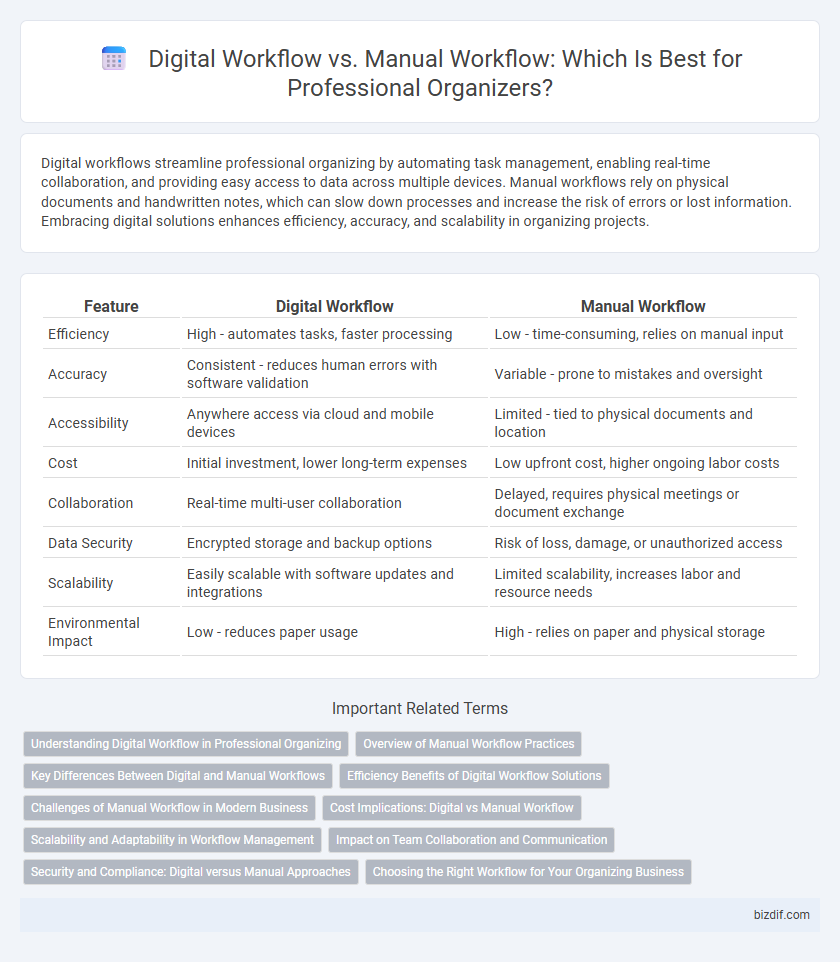Digital workflows streamline professional organizing by automating task management, enabling real-time collaboration, and providing easy access to data across multiple devices. Manual workflows rely on physical documents and handwritten notes, which can slow down processes and increase the risk of errors or lost information. Embracing digital solutions enhances efficiency, accuracy, and scalability in organizing projects.
Table of Comparison
| Feature | Digital Workflow | Manual Workflow |
|---|---|---|
| Efficiency | High - automates tasks, faster processing | Low - time-consuming, relies on manual input |
| Accuracy | Consistent - reduces human errors with software validation | Variable - prone to mistakes and oversight |
| Accessibility | Anywhere access via cloud and mobile devices | Limited - tied to physical documents and location |
| Cost | Initial investment, lower long-term expenses | Low upfront cost, higher ongoing labor costs |
| Collaboration | Real-time multi-user collaboration | Delayed, requires physical meetings or document exchange |
| Data Security | Encrypted storage and backup options | Risk of loss, damage, or unauthorized access |
| Scalability | Easily scalable with software updates and integrations | Limited scalability, increases labor and resource needs |
| Environmental Impact | Low - reduces paper usage | High - relies on paper and physical storage |
Understanding Digital Workflow in Professional Organizing
Digital workflow in professional organizing streamlines task management and data integration through software tools like project management apps and cloud storage. It enhances efficiency by automating scheduling, tracking progress, and centralizing client information for easy access and collaboration. Embracing digital workflows reduces errors and saves time compared to traditional manual methods, leading to more organized and productive project execution.
Overview of Manual Workflow Practices
Manual workflow practices in professional organizing rely on physical tools such as paper lists, filing systems, and handwritten notes to manage tasks and information. These methods emphasize tactile interaction and visual organization, often favored for their simplicity and reduced dependence on technology. However, manual workflows can be time-consuming and prone to human error compared to digital alternatives.
Key Differences Between Digital and Manual Workflows
Digital workflows leverage automation tools, cloud integration, and real-time collaboration platforms to enhance efficiency and reduce human error, while manual workflows rely heavily on paper-based processes and physical documentation. Digital workflows allow for quicker task tracking, easier data retrieval, and seamless updates, contrasting with the slower, more cumbersome nature of manual workflows that require manual input and physical filing systems. Key differences include scalability, speed, accessibility, error reduction, and the ability to integrate with other digital systems in professional organizing contexts.
Efficiency Benefits of Digital Workflow Solutions
Digital workflow solutions significantly enhance efficiency by automating repetitive tasks, reducing errors, and centralizing information access, resulting in faster project completion and improved collaboration. These systems enable real-time updates and seamless integration with other software tools, which streamlines task management and resource allocation. Compared to manual workflows, digital workflows minimize time spent on administrative duties, allowing professionals to focus on strategic activities and client engagement.
Challenges of Manual Workflow in Modern Business
Manual workflows in modern business face significant challenges such as increased error rates, time inefficiency, and limited scalability, which hinder productivity and growth. Reliance on physical documents and manual data entry often leads to data loss and miscommunication across teams, impacting decision-making processes. Transitioning to digital workflows improves accuracy, streamlines task management, and supports real-time collaboration, addressing these critical limitations effectively.
Cost Implications: Digital vs Manual Workflow
Digital workflows significantly reduce costs by minimizing paper usage, storage space, and manual labor expenses compared to manual workflows. Automation tools streamline task management and data entry, cutting down errors and rework costs, which often inflate budgets in manual processes. Over time, the initial investment in digital solutions yields higher ROI through increased efficiency and reduced operational overhead.
Scalability and Adaptability in Workflow Management
Digital workflows offer superior scalability by automating repetitive tasks and integrating with multiple software platforms, enabling seamless expansion without proportional increases in resource allocation. Manual workflows lack the flexibility to adapt quickly to changing project demands or scaling requirements, often resulting in bottlenecks as complexity grows. Workflow management systems powered by digital tools provide dynamic adaptability through customizable automation and real-time data tracking, facilitating efficient adjustments and continuous improvement.
Impact on Team Collaboration and Communication
Digital workflows enhance team collaboration by enabling real-time updates, centralized document sharing, and seamless communication across platforms. Manual workflows often lead to delays and miscommunication due to reliance on physical documents and asynchronous updates. Streamlined digital processes improve transparency and accountability, fostering more efficient and coordinated team efforts.
Security and Compliance: Digital versus Manual Approaches
Digital workflows enhance security and compliance by enabling encrypted data storage, automated audit trails, and real-time access controls, which significantly reduce the risk of data breaches compared to manual workflows. Manual workflows rely heavily on physical document handling and paper trails, increasing vulnerability to loss, unauthorized access, and compliance errors. Implementing digital solutions ensures consistent adherence to regulatory standards such as GDPR and HIPAA through systematic monitoring and secure data management protocols.
Choosing the Right Workflow for Your Organizing Business
Selecting the ideal workflow for your organizing business involves evaluating efficiency, scalability, and client preferences. Digital workflows enhance productivity through automation, seamless collaboration, and real-time updates, while manual workflows offer tactile control and personalized processes. Balancing these methods depending on project complexity and resource availability ensures optimized organization and client satisfaction.
Digital workflow vs Manual workflow Infographic

 bizdif.com
bizdif.com